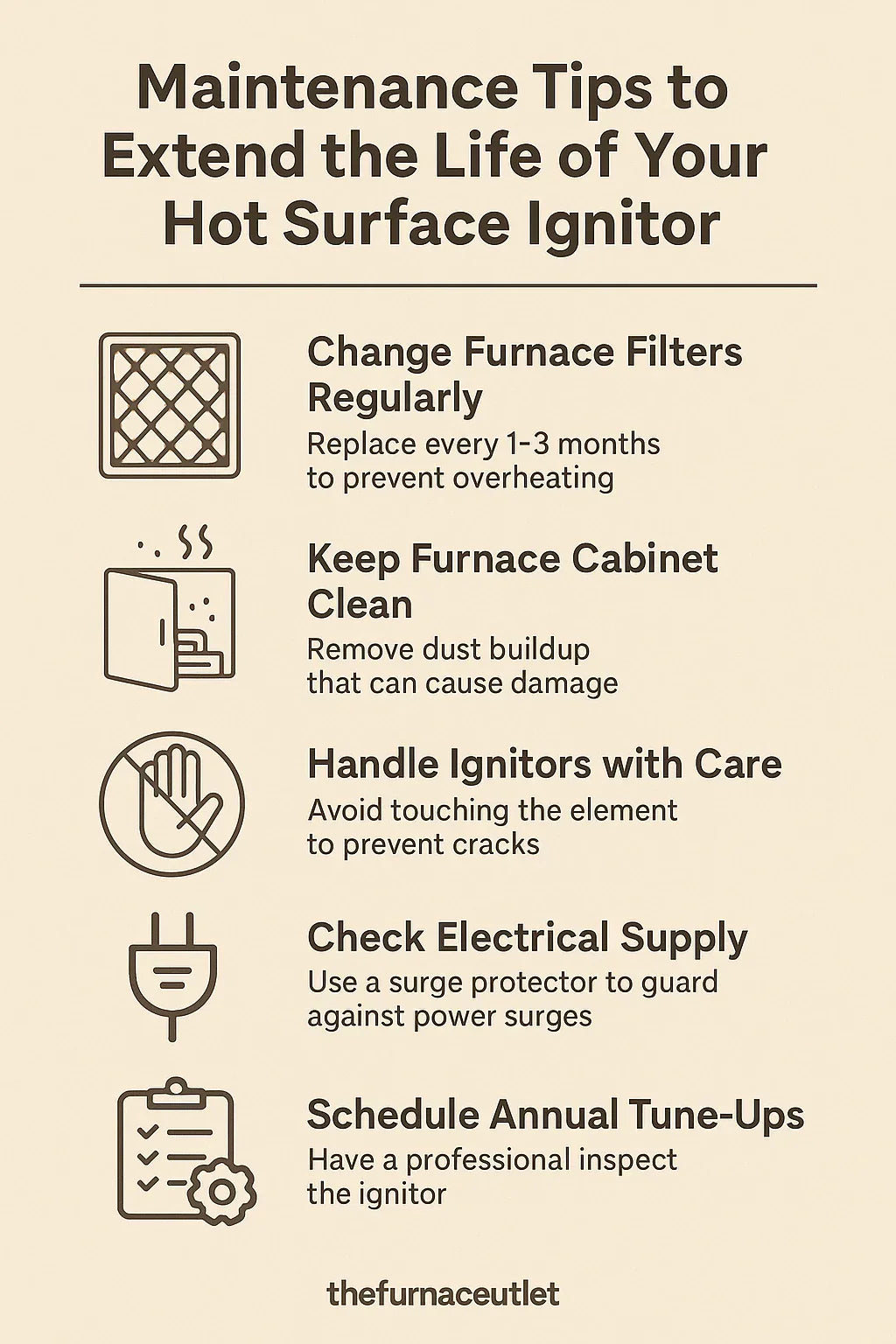Your furnace’s hot surface ignitor (HSI) is small, but it plays a big role: without it, your furnace can’t light the burners. That means no ignition, no flame, and no heat. While ignitors are considered a “wear item” — like light bulbs or filters — you can take steps to make them last longer.
With proper maintenance, a silicon nitride ignitor (like the Goodman 0130F00008S) can last 5–10 years, compared to just 3–5 years for older silicon carbide ignitors. By following some simple best practices, Savvy homeowners can reduce the risk of untimely failures and avoid costly service calls.
Let’s dive into the practical tips that extend the life of your ignitor and keep your furnace running efficiently year after year.
🔥 Why Maintenance Matters for Hot Surface Ignitors
Hot surface ignitors fail primarily due to:
-
Thermal stress from repeated heating cycles
-
Dust buildup that causes overheating
-
Electrical surges or improper voltage
-
Physical damage from rough handling
Since ignitors heat up and cool down thousands of times each winter, they’re naturally prone to wear. However, preventive care can double their lifespan.
For background on ignitor operation, see HVAC School – Hot Surface Ignitors.
🪠 1. Change Furnace Filters Regularly
One of the simplest maintenance tasks — and one of the most impactful — is keeping your air filter clean.
-
A dirty filter restricts airflow, causing the furnace to run hotter than intended.
-
This overheats the burner area, placing extra stress on the ignitor.
-
Clogged filters also increase dust circulation inside the furnace, further coating the ignitor.
Savvy Tip:
-
Replace 1-inch filters every 1–3 months.
-
Replace 4-inch pleated filters every 6–12 months.
-
Consider upgrading to MERV 8–11 filters for better dust control without restricting airflow too much.
For official advice, see Energy Star – HVAC Maintenance Tips.
🧹 2. Keep the Furnace Cabinet Clean
Dust is an ignitor’s silent enemy. Over time, particles build up on the ignitor surface, causing hot spots that lead to cracks.
Steps to keep it clean:
-
Turn off power and gas to the furnace.
-
Remove the access panel.
-
Use a shop vacuum with a soft brush attachment to clean around:
-
Burner compartment
-
Blower assembly
-
Return air plenum
-
-
Avoid direct contact with the ignitor.
👉 Cleaning every fall before heating season extends not only ignitor life but also blower, flame sensor, and control board performance.
For guidance, see Family Handyman – Furnace Repair & Cleaning.
✋ 3. Handle Ignitors with Extreme Care
Hot surface ignitors are incredibly fragile — as delicate as a light bulb filament.
Golden Rules:
-
Never touch the heating surface with bare hands. Oils from your skin cause uneven heating → premature failure.
-
Always handle by the ceramic base.
-
Wear clean gloves if replacement is required.
-
Avoid tapping or dropping the ignitor — even small impacts can crack it.
If you’re installing a Goodman OEM ignitor like the 0130F00008S, treat it like glass.
⚡ 4. Check Furnace Electrical Supply
Ignitors are sensitive to electrical fluctuations. A power surge or incorrect voltage can destroy them instantly.
How to protect your ignitor:
-
Use a dedicated surge protector or whole-home surge protection.
-
Check your furnace circuit for stable voltage (typically 120V).
-
If you suspect electrical issues, test ignitor resistance with a multimeter:
-
Silicon nitride: ~40–90 ohms
-
Infinite resistance = bad ignitor
-
👉 Consistent power supply = longer ignitor lifespan.
For more on troubleshooting, see ACHR News – Ignition Systems.
🛠️ 5. Schedule Annual Furnace Tune-Ups
Even the most proactive homeowner benefits from a professional inspection. During a tune-up, an HVAC technician will:
-
Test ignitor resistance to detect early wear
-
Inspect the flame sensor and burners
-
Clean internal components
-
Verify airflow and gas pressure
-
Check control board and electrical connections
Catching a weak ignitor early lets you replace it before it fails on a freezing night.
For average maintenance costs, see Furnace Service Pricing.
👀 6. Know the Warning Signs of Ignitor Failure
Even with good maintenance, ignitors eventually wear out. Recognizing the early signs gives you time to act before the furnace quits:
-
❌ Furnace won’t ignite (no flame)
-
❌ Short cycling (furnace starts and stops repeatedly)
-
❌ Blower runs but blows cold air
-
❌ Clicking or humming sounds with no ignition
-
❌ Visible cracks, white spots, or burn marks on ignitor
👉 If you spot these, it’s time to replace with a Goodman 0130F00008S OEM ignitor.
For troubleshooting steps, see RepairClinic – Furnace Ignitor Replacement.
💡 Savvy Homeowner Strategy: Keep a Spare Ignitor on Hand
Because ignitors are low-cost parts ($30–$80) and relatively easy to replace, many homeowners keep a spare on hand.
Benefits of this strategy:
-
Avoids waiting for shipping during peak winter season
-
Saves money on emergency service calls
-
Provides peace of mind when the furnace shows early warning signs
👉 Order an OEM Goodman 0130F00008S in advance, store it in its protective packaging, and you’ll always be ready.
✅ Final Savvy Homeowner Takeaway
Hot surface ignitors are consumable parts — they will eventually fail. But with good care, you can extend their lifespan and avoid untimely breakdowns.
-
🔹 Change filters regularly to prevent overheating.
-
🔹 Keep the furnace cabinet clean to minimize dust buildup.
-
🔹 Handle ignitors carefully — always by the base, never the tip.
-
🔹 Protect against electrical surges.
-
🔹 Schedule annual tune-ups for early detection.
-
🔹 Know the signs of failure and act quickly.
-
🔹 Keep a spare OEM ignitor ready to go.
👉 Following these steps, your Goodman 0130F00008S ignitor can last up to a decade — saving you money and keeping your home warm all winter long.
In the next topic we will know more about: Troubleshooting Guide: Furnace Won’t Start but the Ignitor Looks Fine







